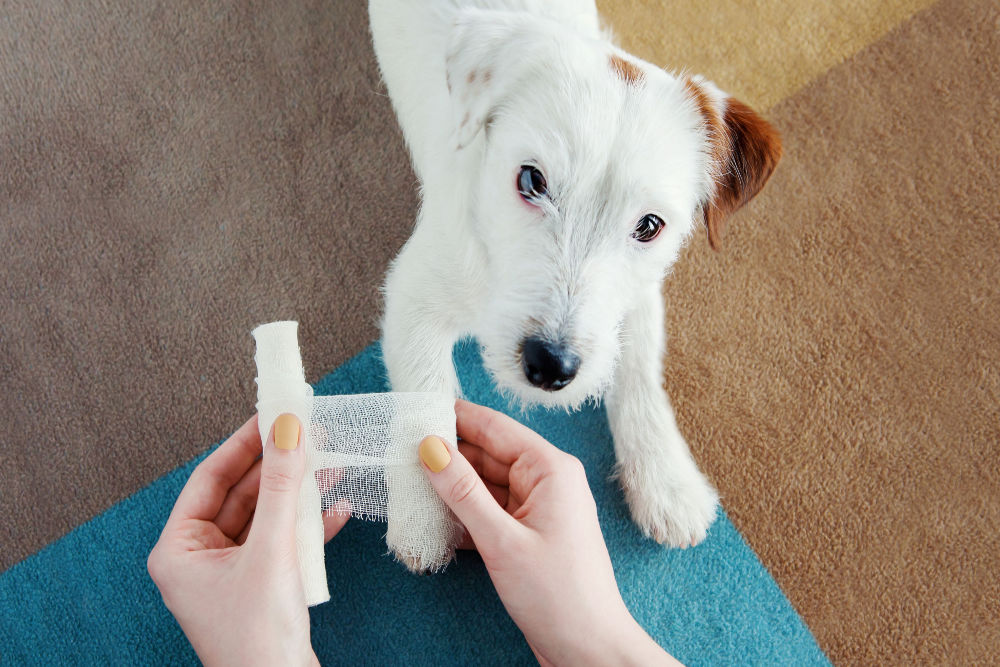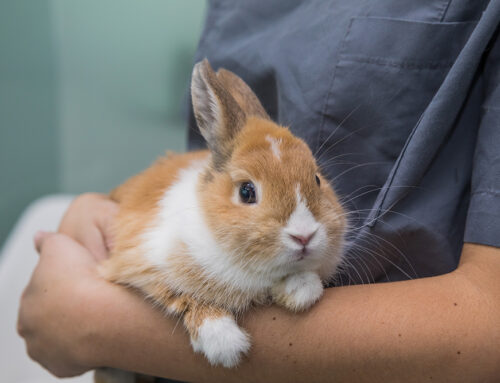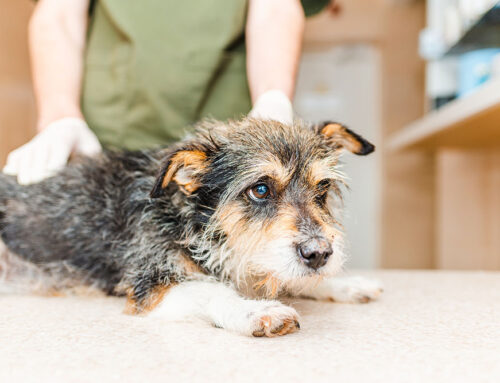Step 1: Stay Calm
Bleeding legs, trouble breathing, poison ingestion – all of these are scary but knowing what to do in an emergency can be crucial to saving your pet’s life.
In an emergency, first aid is not a substitute for veterinary treatment. However, before you are able to get your pet to a veterinarian, knowing some basic first aid can help. Always seek veterinary care following first-aid attempts.
Bite Wounds
Approach the pet carefully to avoid getting bitten. Muzzle the animal. Check the wound for contamination or debris. If significant debris is present, then clean the wound with large amounts of saline or balanced electrolyte solution. If these are not available, then regular water may be used. Wrap large open wounds to keep them clean. Apply pressure to profusely bleeding wounds. Do not use a tourniquet. Wear gloves when possible.
Bite wounds often become infected and need professional care. Call your veterinarian.
Bleeding
Apply firm, direct pressure over the bleeding area until the bleeding stops. Hold the pressure for at least 10 straight minutes (continually releasing the pressure to check the wound will hamper the clotting). Avoid bandages that cut off circulation.
Breathing Stops
Check to see if the animal is choking on a foreign object. If an animal is not breathing, place it on a firm surface with its left side up. Check for a heartbeat by listening to the area where the elbow touches the chest. If you hear a heartbeat but not breathing, close the animal’s mouth and breathe directly into its nose–not the mouth–until the chest expands. Repeat 12 to 15 times per minute. If there is no pulse, apply heart massage at the same time. The heart is located in the lower half of the chest, behind the elbow of the front left leg. Place one hand below the heart to support the chest. Place theother hand over the heart and compress gently. To massage the hearts of cats and other tiny pets, compress the chest with the thumb and forefingers of one hand. Apply heart massage 80-120 times per minute for larger animals and 100-150 per minute for smaller ones. Alternate heart massage with breathing.
Please note: Even in the hands of well-trained veterinary health professionals, the success of resuscitation is very low overall. Success may be slightly higher in the cases of drowning or electrical shock.
Call your veterinarian immediately.
Burns
(Chemical, electrical, or heat including from a heating pad) Symptoms: singed hair, blistering, swelling, redness of skin. Flush the burn immediately with large amounts of cool, running water. Apply an ice pack for 15-20 minutes. Do not place an ice pack directly on the skin. Wrap the pack in a light towel or other cover. If the animal has large quantities of dry chemicals on its skin, brush them off. Water may activate some dry chemicals.
Choking
Symptoms include difficulty breathing, excessive pawing at the mouth, blue lips and tongue. Be sure to protect yourself and the animal, as the pet will likely be frantic and may be more likely to bite. If the pet can still partially breathe, it’s best to keep the animal calm and get to a veterinarian as quickly as possible. Look into the mouth to see if foreign object in throat is visible. If you can, clear the airway by removing the object with pliers or tweezers, being careful not to push it farther down the throat. If it is lodged too deep or if the pet collapses, then place your hands on both sides of the animal’s rib cage and apply firm, quick pressure. Or place the animal on its side and strike the side of the rib cage firmly with the palm of your hand three or four times. Repeat this procedure until the object is dislodged or you arrive at the veterinarian’s office.
Diarrhea
Withhold food for 12-24 hours, but not water. Sometimes pets that appear to be straining are sore from diarrhea rather than from constipation. Your veterinarian can help you decide which it is and what will help. Trying at-home treatments without knowing the real cause can just make things worse.
Fractures
Symptoms include pain, inability to use a limb, or limb at odd angle. Muzzle the pet and look for bleeding. If you can control bleeding without causing more injury, then do so. Watch for signs of shock. DO NOT TRY TO SET THE FRACTURE by pulling or tugging on the limb. Transport the pet to the veterinarian immediately, supporting the injured part as best you can.
Heatstroke
Symptoms include rapid or labored breathing, vomiting, high body temperature, collapse. Place the animal in a tub of cool water. Or, gently soak the animal with a garden hose or wrap it in a cool, wet towel. Do not overcool the animal. Stop cooling when rectal temperature reaches 103 degrees Fahrenheit.
Call veterinarian immediately.
Poisoning
Symptoms include vomiting, convulsions, diarrhea, salivation, weakness, depression, pain. Record what the pet ingested and how much. Immediately call your veterinarian or poison control center. Do not induce vomiting. In case of toxins or chemicals on the skin from oils, paints, insecticides and other contact irritants, request directions on if and how to wash the toxin off.
Seizures
Symptoms include salivation, loss of control of urine or stool, violent muscle twitching, loss of consciousness. Move the pet away from any objects that could be harmful during the seizure. Use a blanket for padding and protection. Do not put yourself at risk by restraining the pet during the seizure. Time the seizure. They usually last only 2 to 3 minutes. Afterwards, keep the animal calm and quiet.
Call your veterinarian immediately.
Shock
Symptoms include irregular breathing, dilated pupils. Shock may occur as a result of a serious injury or fright. Keep the animal gently restrained, quiet, and warm, with the lower body elevated.
Call your veterinarian immediately.
Vomiting
Withhold food for 12-24 hours. Slowly increase the amount of water and foods given over a 24-hour period.
Call your veterinarian.
This information is from the AAHA Healthy Pet website. For more information visit here.
When to Call the Vet
Some emergency situations that may need immediate attention are:
- Vomiting
- Diarrhea
- Unplanned Weight Loss
- Change in Appetite (decreased or increased)
- Change in Normal Activity Level (lethargy, hyperactivity, restlessness)
- Limping Sudden Inability to Move Back Legs
- Coughing, especially at Night
- Bloated Abdomen
- Crying in Pain when Touched
- Clumsy or Disoriented Behavior
- Seizures
- Loss of Consciousness
- Difficulty or Labored Breathing
- Any Blue, Purple, or Pale Hue to the Tongue and Gums
- Sudden Collapse
- Excessive Drooling
- Sneezing Excessively
- Straining in the Litterbox without Producing any Urine
- Crying out while Urinating
- Change in Urination (location, frequency, amount, color, smell)
- Uncontrolled Bleeding Nose-bleed or Bruising
- Any Unusual Odor
- Runny Eyes or Nose
- Squinting
- Panting in a Cat






